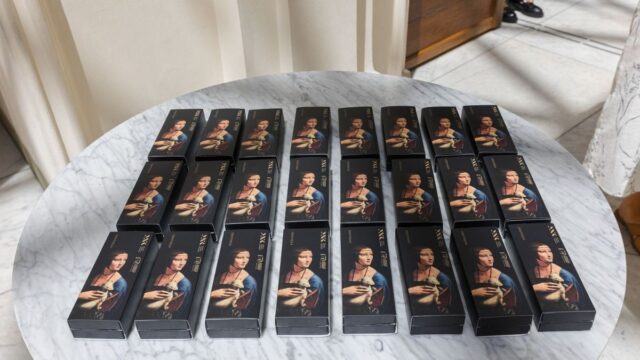At the National Museum in Krakow, you can now smell and buy the smell of Leonardo da Vinci’s ‘Lady with an Ermine’.
The crisp musk of an old book. The sweet sting of a lover’s perfume on the collar of a coat. Smells accentuate our experiences and they bind us to objects, their imaginary memories filtering into our subconscious.
But how far can smell take us when it comes to experiencing masterpieces? ¿We could, for example, really feel like we were there when ‘The Lady with an Ermine’ was first created.?
A team of researchers from Poland and Slovenia is trying to find out, after developing a scented marker of the box Leonardo da Vinci from the 15th century, which visitors to the National Museum of Krakow They can already smell while looking into Cecilia Gallerani’s eyes.
“Institutions often perceive odors emitted by facilities as unnecessary information, and perhaps even undesirable pollution. However, as of now, Visitors will be able to explore the smell of historical objects in a completely new and little-explored way. This project is truly innovative,” says Elżbieta Zygier, Chief Curator of the National Museum in Krakow.
Developed through chemical analysis, the marker tries to reproduce the smell that the object would have had.
“It has a very pleasant historical museum smell,” he adds, also emphasizing that just a small inhalationas maximum.
In addition, you have to change the marker every three or four weeks: “After a month it doesn’t smell the same anymore“.
The world’s first odor library of historical objects
As part of the Odotheka project, the world’s first odor library of historical objects, Sawoszczuk’s team works in collaboration with colleagues from the University of Ljubljana and the National Museum of Slovenia to recreate the smells of others nine objects of great importance for Polish and Slovenian heritage.
Among them, a tobacco box belonging to Franc Prešeren, the Slovenian national poet, and a hygienic powder manufactured in Krakow in the 1920s that won a gold medal at an exhibition in Paris and was advertised in the newspapers by Pola Negri, a Hollywood star of Polish origin.
The project It started in 2021after the National Museum in Krakow asked Sawoszczuk to evaluate the quality of the air inside the glass casing that housed “Lady with an Ermine”.
“I just thought, okay, I’m one of the few people in the world who can get close to the object without any glass and that it would be nice to pick up the smell of this painting and bring it to light”.
Although everything intrinsically has a smell, This one also evolves over time. depending on what happens to an object and where it is stored. In this way, you can never really capture the original smell of something, but you can draw a timeline.
“We do not measure or recreate the original smell of the objects, because the objects have their own history. We are aware that along the historical path of the objects, they were in different places. They were subjected to different conservation treatments.”
Another added advantage? Conservation treatments make bad odors a rarity.
Sensory tourism
“Smells have a stronger persuasive power than words.appearances, emotions or will,” wrote German writer Patrick Süskind in his 1985 novel “Perfume: Story of a Murderer.”
Still, not even Michelin-starred British chef Heston Blumenthal could convince movie audiences that eat and smell fermented fish paste during the screening of the film adaptation of the book in 2011 was a good idea.
For decades, art galleries have contemplated forms of make the experience more attractive of seeing something through multisensory techniques.
Although at times it is effective (William Castle’s film The Tinglerfrom 1959, and its vibrating seats) or lackluster and exaggerated (immersive art exhibitions), the incorporation of more tactile elements to cultural spaces makes sense in a digital era in which establishments have financing problems and people need more convincing to go out on the streets.
It also answers Maya Angelou’s adage that people will never forget how you made them feel.
Us [el equipo de investigación] We joked that now it’s like sightseeing in 4K: You don’t just use your eyes to see objects, you don’t just use your ears with the audio guideyou don’t just use touch because, outside the display case of “The Lady with an Ermine”, there is the 3D copy of it, so you can touch the copy“, dice Sawoszczuk.
We hope that all this, together with the aromascreate a truly immersive experience that enhances our understanding and emotional response to what we are seeing.
And what is more important, Adding tailored scents could greatly improve the gallery experience and museums for people who are blind or partially sighted, helping them feel more connected to historical objects.
“One of the most important parts of this project is studying people’s emotions after exposure. We will also do the same with blind people and ask them if this way of sightseeing with smell is attractive to them., and how it influences your emotions about the exhibition itself. This is what we want to collect,” says Sawoszczuk.








